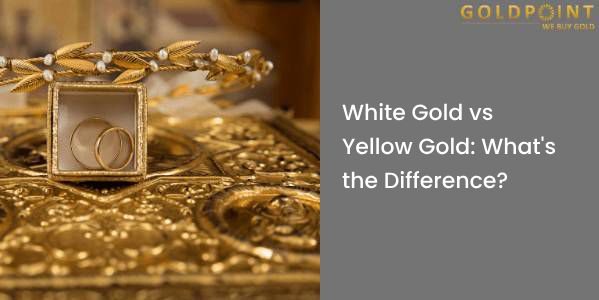
- Jun, 30 2023
- | Sell Gold
White Gold vs Yellow Gold: What’s the Difference?
White gold and yellow gold are the two most in-demand metals for jewellery. While yellow gold is a classic choice, white gold is a modern alternative for jewellery-making. The rates of gold jewellery created using these metals differ and anyone interested in selling gold jewellery must be aware of them.
Both metals are made of gold and share several similarities, but some factors can differentiate them. Yellow gold offers some benefits, including resizing and zero plating. On the other hand, jewellery made of white gold is more resistant to dents and scratches than yellow gold. It is due to the different mixtures of metals in it.
Want to know more about the difference between white and yellow gold? Read on.
The History of White and Yellow Gold
Gold has been a part of many civilisations for thousands of years. Ancient cultures from Egypt, Mesopotamia and India have used gold for jewellery-making and adornment.
In Egypt, gold was believed to represent the Sun God Ra. In ancient Rome, gold jewellery symbolised wealth and status. During the European Middle Ages, yellow gold was used widely to create religious objects, such as crosses, altars, etc.
The 19th century was the age when white gold was invented. White gold first emerged in the 1920s as a low-cost alternative to platinum.
The Pros and Cons of White and Yellow Gold
Pros
White Gold
- White gold is more durable and scratch resistant than gold as it is an alloy of more solid metals.
- It is more affordable than its counterpart, platinum.
- It has a modern feel.
- It is preferred for jewellery with diamonds and gemstones as its white colour complements all colours.
Yellow Gold
- Yellow gold is easy to maintain.
- It has a vintage feel for classic lovers.
- It is a highly hypoallergenic metal.
- When selling gold jewellery, it is more valuable than white gold as it contains more gold.
- The softness of yellow gold can work in favour of customers. They can resize a ring made in yellow gold easily.
Cons
White Gold
- White gold sometimes contains nickel that may be allergic to many individuals.
- It needs re-plating with rhodium to maintain the optimal appearance, which adds to its maintenance cost.
Yellow Gold
- Yellow gold is prone to dents and scratches.
- Depending on the alloy mix, it can stain under certain conditions with a black mark.
- It needs to be polished over time.
How is White Gold Different From Yellow Gold
| White Gold | Yellow Gold | |
| Making | White gold is a mix of pure gold and other metals (nickel, palladium, or silver) with increased durability. It is often coated with a layer of rhodium metal that enhances its shine. | Yellow gold is a mix of pure gold, copper and sometimes, silver. This mix results in the signature yellow colour. More gold content makes it more yellow. |
| Appearance | White gold gives a cool tone to the jewellery with a silvery-white shade. | Yellow gold gives it a shade of warm golden colour. |
| Use | White gold is famous for engagement rings and wedding bands. | Yellow gold is preferred for traditional jewellery designs. |
| Price | Since white gold coated with rhodium requires replating over time, it adds to the cost. | Gold jewellery rate depends on purity. No plating is required for yellow gold. |
Is White Gold Real Gold?
White gold is real gold. Here’s how:
- The amount of metals mixed in pure gold affects its final colour and properties. White gold is an alloy of gold and other white metals like nickel, palladium, and silver. This mixture causes the colour change. Moreover, white gold has a special coating, giving it a glossy beauty.
- Since pure gold is a very soft metal, it bends easily. Therefore, to use gold in jewellery making, mixing it with harder metals is necessary. Alloying it with other metals helps gold to retain its shape and designs. The process of alloying makes gold more durable.
Conclusion: Which One Should You Get?
- The preference for white gold and yellow gold depends on personal choice, style, and use. Both types of gold have their own unique benefits.
- Individuals who buy gold as an investment or consider it a reserve to overcome adversities prefer high-carat gold. Gold jewellery rate increases with the higher carats. Selling your gold jewellery of high carats can provide you with enough funds in a financial emergency.










